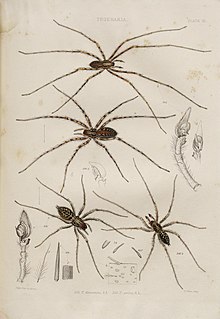| Eratigena duellica | |
|---|---|
 | |
| Scientific classification | |
| Domain: | Eukaryota |
| Kingdom: | Animalia |
| Phylum: | Arthropoda |
| Subphylum: | Chelicerata |
| Class: | Arachnida |
| Order: | Araneae |
| Infraorder: | Araneomorphae |
| Family: | Agelenidae |
| Genus: | Eratigena |
| Species: | E. duellica |
| Binomial name | |
| Eratigena duellica (Simon, 1875) | |
| Synonyms | |
| |
Eratigena duellica, the giant house spider, is a species of funnel weaver in the spider family Agelenidae. Originally from Europe, it is also found in British Columbia, Canada, as well as Washington and Oregon in the United States. [1] [2] [3] The related species Eratigena atrica is also called the giant house spider.
Eratigena atrica was transferred from the genus Tegenaria in 2013. It was considered the same species as Eratigena atrica until 2018, when Eratigena duellica, Eratigena saeva , and Eratigena atrica were restored as separate species. [4] [5]